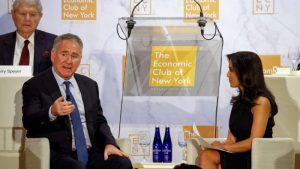Amazon says workers need to be in the office. Most of Silicon Valley disagrees.
Amazon chief executive Andy Jassy has brooked little dissent since he ordered staff back into the office three days a week in May last year.
“If you can’t disagree and commit . . . it’s probably not going to work out for you,” Jassy warned those who continued to gripe during a town hall in August 2023, brushing off an earlier walkout staged by hundreds of disgruntled staff at its Seattle headquarters.
This week, Amazon doubled down. More than 300,000 of its corporate employees around the world have been told they must revert to the traditional five-day week from the start of 2025, one of the strictest return-to-office policies among big tech groups.
“Before the pandemic, it was not a given that folks could work remotely two days a week, and that will also be true moving forward,” Jassy wrote in a staff memo on Monday. “The advantages of being together in the office are significant . . . You need to be joined at the hip with your teammates when inventing and solving hard problems.”
By doing so Jassy — who has been at Amazon since 1997, helped found Amazon Web Services and replaced founder Jeff Bezos as chief executive in mid-2021 — has become the figurehead of a growing number of executives pushing for a full return to the office, including Jamie Dimon at JPMorgan Chase and Elon Musk at Tesla.
While Amazon’s stance is less draconian than Musk’s — who told Tesla staff in 2022 that if they are not in the office at least 40 hours a week they can “pretend to work somewhere else” — the policy puts Amazon at odds with most of its tech rivals.
Only 3 per cent of tech companies with more than 25,000 employees are back to five days in the office, according to software firm Flex Index, which analysed the policies of 2,670 companies. Almost three-quarters follow a structured hybrid pattern and 23 per cent offer fully flexible terms.
Apple, Alphabet, Meta and Microsoft are among those that, at least for now, have settled on a hybrid working pattern, but even these more lenient policies have had multiple revisions and persistent pushback from staff.
In 2020 Mark Zuckerberg said Facebook, now called Meta, would become “the most forward-leaning company on remote work”. Last year he called almost all of Meta’s 70,000 employees back to the office at least three days a week.
Google’s human resources chief told staff in June last year that full remote working would be permitted “by exception only”. She added that office attendance would be monitored via staff ID badges and would factor in their performance reviews and promotions.
Apple gradually added more days to its “return to office” mandate throughout 2022, starting at just one in March and building up to three by August, despite resistance from some of its 160,000 workers.
Even Zoom, whose software facilitated much of the initial boom in remote working during the pandemic, said in August last year that any employees living within 50 miles of an office would be obliged to come in at least two days a week.
Other tech groups, including Netflix and Nvidia, have not yet issued a fixed universal mandate for in-person office attendance.
Amazon’s hardline experiment will be closely tracked by other leaders when it begins on January 2. At the August 2023 town hall, Jassy said “scores” of other chief executives he spoke to felt the same way about remote work and “virtually all of them” wanted staff back in person full time.
T-Mobile chief executive Mike Sievert has encouraged rival companies to bring their staff back to the office too, telling business leaders at a Technology Alliance event in May in Seattle: “Y’all gotta get back to the offices.”
But many are still wary of breaking the fragile truce and view hybrid contracts as an advantage in recruiting young engineering and coding talent, as well as candidates from more diverse backgrounds, for whom flexibility is often a priority.
“We certainly don’t have any plans to do [the same],” said one rival west coast Big Tech executive. “It feels a bit like performatively shooting themselves in the foot.”
Prithwiraj Choudhury, a professor at Harvard Business School, said: “Any company which does a forceful top-down return to office policy will lose a portion of the best performers, because the best performers always have outside options.”
Research from the University of Pennsylvania found that remote positions in technology groups attracted 15 per cent more female applicants and 33 per cent more applicants from minorities under-represented in the sector.
Some Amazon staff have complained online. One posted on LinkedIn they were seeking a new job, calling the five-day mandate “unfortunate because I’m interested in working for a living, not live-action role-playing and virtue signalling”.
There is little prospect of the company making a U-turn. Jassy put the policy at the centre of measures designed to revive Amazon’s notoriously hard-charging “Day 1” culture, enforced in the early years by Bezos. One of Bezos’s shortlisted names for the company was Relentless.com and the domain still redirects to Amazon.com today.
Executives are concerned that start-up ethos has slipped and bureaucracy has taken hold as the company has exploded to 1.5mn staff and expanded its business from ecommerce to cloud computing, healthcare and self-driving cars.
Jassy said in this week’s memo: “As we have grown . . . we have also added more layers than we had before. It’s created artefacts that we’d like to change — eg pre-meetings for the pre-meetings for the decision meetings — that create overhead and waste valuable time.”
Amazon has shown it is willing to enforce its office rules. After the three-day mandate was introduced last year, the company monitored staff attendance via their ID passes and sent chastising emails to those not meeting the minimum requirements, the Financial Times reported at the time.
A cull of middle managers is also planned — as many as 7,000 could go to save $700mn annually, according to estimates from Bank of America analyst Justin Post — adding to the 27,000 staff Amazon said it would lay off last year to cut costs and reshape its bloated corporate operations.
“It’s not obvious why Amazon is doing this,” said Nicholas Bloom, a professor of economics at Stanford University. “If Amazon wants to achieve a headcount reduction then this is one way to do it — but one group that’ll leave is high performers.”
Bloom added that Amazon’s shift may be supported, in part, by research from Stanford Business School that showed workers were more innovative and creative in face-to-face meetings, although he noted that “doesn’t mean you have to go in every day”.
His own research, published in July, found that hybrid work was no less productive than fully in-person work — although fully remote work was tied to a productivity drop of about 10 per cent.
Executives who want staff back have been emboldened by a tightening labour market as the post-pandemic hiring boom subsides, which has shifted the balance of power back towards employers. Tech companies cut 263,000 jobs in 2023 and tens of thousands more have followed this year.
If successful, Amazon’s attitude could spread more widely. “We haven’t yet settled on post-Covid working norms,” said David D’Souza, membership director for the CIPD, the UK’s professional body for HR. “Whenever a high-profile company like Amazon makes a decision like this it prompts similar discussions in other organisations as well.”
#Amazon #workers #office #Silicon #Valley #disagrees








